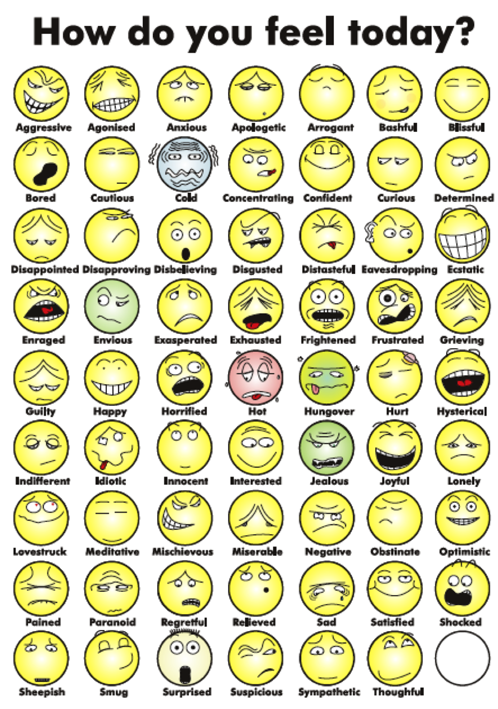Last week I wrote about thoughts not being facts and how we can manage our thoughts by recognising them for what they are – mood-driven mental events that pop up in our mind. Just like thoughts, feelings aren’t facts either (I think we’re starting to see a pattern here…).
According to Barton Goldsmith PhD, author of Emotional Fitness, emotions can be produced in response to a number of things:
A recent event
Something from our past,
Fantasies we have created
Misconceptions around an event
Lies we tell ourselves to confirm our own perspective of the world.
Barton notes that we may truly believe our emotions are real – they may feel very real – but they are just feelings, and feelings aren’t facts. The trick is to learn how to differentiate between feelings that result from our imagination versus those that are real.
Markman goes on to say: “Emotions provide valuable information …..Ignoring them is like driving around lost, not only refusing to ask for directions, but refusing to consult the map or the GPS, or even to look out the windshield. You will still be moving forward, but who knows where you will end up. Conversely, paying too much attention to your feelings is also bad. That’s like staring at your road atlas without ever turning on the car: you can’t get anywhere that way.”
So, how do we work out whether a feeling is real or not, or what it is telling us?
One of the best ways to understand our emotions better is to be aware that they are many and varied, and to be able to recognise them and name them. Many of us have a limited ‘emotional vocabulary’ and expanding it can help us to understand ourselves, and others, better.
Knowing what emotion we are experiencing gives us valuable information about our ‘map’ and helps us to navigate our responses to events.
A great way to build our emotional vocabulary is by having a visual guide to emotions. Attached is a brilliant resource which lists a series of emojis with their accompanying ‘emotion’. Using this list, we can develop a much more nuanced understanding of what we are feeling and what others may be feeling..How many do you recognise? How many do you feel on a daily basis?
A senior leadership team I worked with introduced this chart. It was used during every team meeting and offsite to help the team check in with themselves and each other to uncover what they were really feelingI remember one particular meeting where we were wrapping up and quickly went around the room to note each person’s ‘emotion’. Rather than the tacit agreement which often occurs at the end of meetings, one brave senior leader said ‘I’m feeling scared’. This opened up an entirely new conversation about how the team were supporting each other and how the priorities were being shared. Being able to have this conversation built trust and broke down some barriers within the team.
Emotions are complex – for everyone
Susan David, the author of Emotional Agility noted that: “Labelling emotions is at the core of our ability to empathise. We know that we can be excited, anxious and frustrated all at the same time and we need to learn to be able to recognise and acknowledge that complexity in other people.”
Sometimes, an event that happened first thing in the morning, a fight with your partner for example, can lead to us interpreting an event later that day, such as a negative conversation with a colleague, as far worse than it actually is. We’re feeling through the lens of our earlier argument.
In his article You can’t manage emotions without knowing what they really are Art Markman suggests some steps we can take to understand our emotions better:
Breathe – When you have a strong emotion, take five minutes to sit alone and breathe deeply. This takes some of the energy or arousal out of the feelings.
Dig Deeper – Reflect on your day – are there particular events that increase or decrease the intensity of that feeling? What really drove your emotion?
Action Plan – Once you’ve figured out what’s bothering you, it is time to plan a course of action. Ruminating on an event can lead to inaction, whilst also getting more upset. If you’re really upset, hold off on your plan until you have calmed down. Often our perspective on the best way forward changes with a cool head.
Suppressing emotions only makes them stronger!
According to Goldsmith, ‘pushing down a feeling, or ignoring it won’t work. Feelings don’t co-operate’. Yet many of us actively push away and suppress our feelings – we become emotionally numb.
Peter Bregman, author of 18 Minutes, notes that: “Simply being able to feel is a feat in itself. We often spend considerable unconscious effort ignoring what we feel because it can be painful. Who wants to be afraid or jealous or insecure? So we stifle the feelings, argue ourselves out of them, or distract ourselves with busy work or small talk.”
Instead of buffering of how we feel, repressing emotions guarantees they won’t go away. They will keep surfacing until you do process them. As Bregman says, in the organisational context suppressing our emotions is “where passive aggressiveness is born, which we all know is one of the key foundations of dysfunctional organisational politics.”
Many of us are socialised to believe that certain feelings aren’t acceptable. I remember It was a revelation for me when a close friend said to me: “Why do you keep saying you shouldn’t feel a certain way? There are no bad feelings.”
My friend was right and our effort is better spent recognising and understanding our feelings instead of repressing them. Here’s two daily practices that can support your emotional understanding:
Journaling is a great way to understand our emotions better. It’s a tool used by many successful business leaders and entrepreneurs. Some make it a daily habit to complete ‘morning pages’, where they simply write down what they are experiencing for 10-20 minutes each morning as a way of processing and clarifying what they are thinking and feeling.
Mindfulness exercises are a powerful way to help us become more aware of our emotions, without passing judgment on them. They allows us some space to separate from what we are feeling and accept that feeling without judging it. Mindfulness helps us to acknowledge that emotions are fleeting.
Building this emotional understanding helps us to become better at managing ourselves and our teams. It helps us to become more emotionally agile, which is a key leadership skill both now and into the future. On a personal level, being better at labelling and understanding our emotions at a granular level helps us to cope better with rejection and can improve anxiety, depression and our overall wellbeing.
Next week we’ll complete our emotional agility journey by delving into the fascinating world of the stories we tell ourselves.



